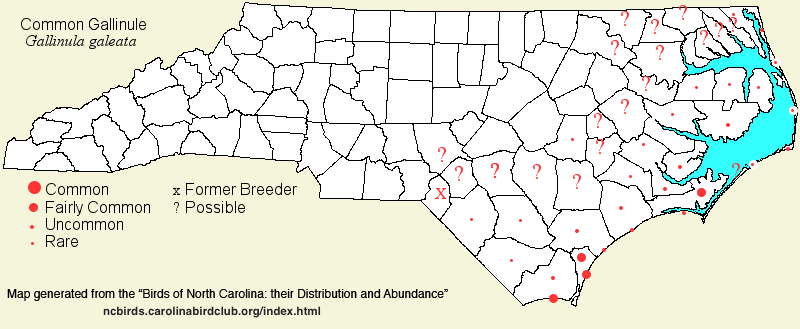 |  |
|
Common Gallinule - Gallinula galeata RALLIDAE Members: | Search Common: Search Scientific: |
|
|
|||||||
| General Comments | This species is a "cousin" of the Purple Gallinule, occurring in similar freshwater ponds, though the Common Gallinule is a swimmer, for the most part, and not a walker/wader. Fortunately, the Common Gallinule [called Common Gallinule several decades ago, but changed to Common Moorhen until 2011] is a regular and not scarce breeder in the Coastal Plain, though it is quite local and particular about its breeding ponds, being inexplicably scarce in some areas, such as the Bodie-Pea Island area, but yet often nesting in tiny ponds, such as at golf courses and in coastal towns. Its breeding population has held steady or declined slightly over the past few decades. It also winters in the same areas, but in much reduced numbers by midwinter. Breeding and wintering habitat is always freshwater ponds, impoundments, and lake shores, where there is marshy cover, and usually (but not necessarily) floating or other emergent vegetation in the middle of the pond. Though this species breeds well inland in the Central States and near the Great Lakes, it is essentially absent as a breeder between the Coastal Plains of the Atlantic and Gulf States and the Mississippi River. | ||||||
| Breeding Status | Breeder | ||||||
| NC BRC List | Definitive | ||||||
| State Status | W | ||||||
| U.S. Status | |||||||
| State Rank | S3B,S2N | ||||||
| Global Rank | G5 | ||||||
| Coastal Plain | Permanent resident near the coast, but with strongly migratory movements; farther inland, very local as a breeder, and quite scarce as a migrant and in winter. Generally uncommon to locally fairly common breeder, and mostly uncommon in midwinter, along and near the coast north to Cape Hatteras; most numerous in the southern counties. Uncommon at best along the northern coast, at all seasons. In the Tidewater zone, very local breeder, and mostly uncommon; rare in winter; probably most regular at Mattamuskeet NWR. Farther inland, rare and local breeder, but does nest as far inland as Goldsboro and some Carolina bay lakes in the Robeson/Bladen area, if not farther inland; scarce in migration, and a few winter records from the interior, mainly at Goldsboro. Likely nested at a millpond in Bladen in 2024. Peak counts: 75, Sunset Beach, 22 Jan 1989. Recent peak count: 25, White Oak Impoundment (Onslow), 28 Jul 2024. | ||||||
| Piedmont | Scarce transient. Very rare to rare and easily overlooked transient (as birds tend to be secretive along and in marshes at lakes and ponds); mainly mid-Apr to late May, and early Sep to mid-Nov. Casual in winter: two, Mecklenburg, 30 Dec 1989; one, Salem Lake (Forsyth), 5 Jan 2013; and one, Indian Trail (Union), 28 Nov - 12 Dec 2021. A most intriguing report is of two "young birds" at North Wilkesboro, 10 Jul 1965. This suggests local breeding, which has never been confirmed in the province. Peak counts: | ||||||
| Mountains | Scarce transient (only about 12 records). Very rare at low elevations in the southern mountains; late Apr to mid-May, and mid-Sep to early Nov. Remarkable was one that overwintered at a pond in Henderson during 2007-08. Peak counts: | ||||||
| Finding Tips |
Your best chances for seeing this species are along the southern coast, where more widespread than farther north. The Twin Lakes area on the mainland portion of Sunset Beach is your best bet. *** | ||||||
| Attribution | LeGrand[2025-07-23], LeGrand[2024-10-29], LeGrand[2024-08-02] | ||||||
| NC Map Map depicts all counties with a report (transient or resident) for the species. | Click on county for list of all known species. |
| NC Breeding Season Map Map depicts assumed breeding season abundance for the species. |  |